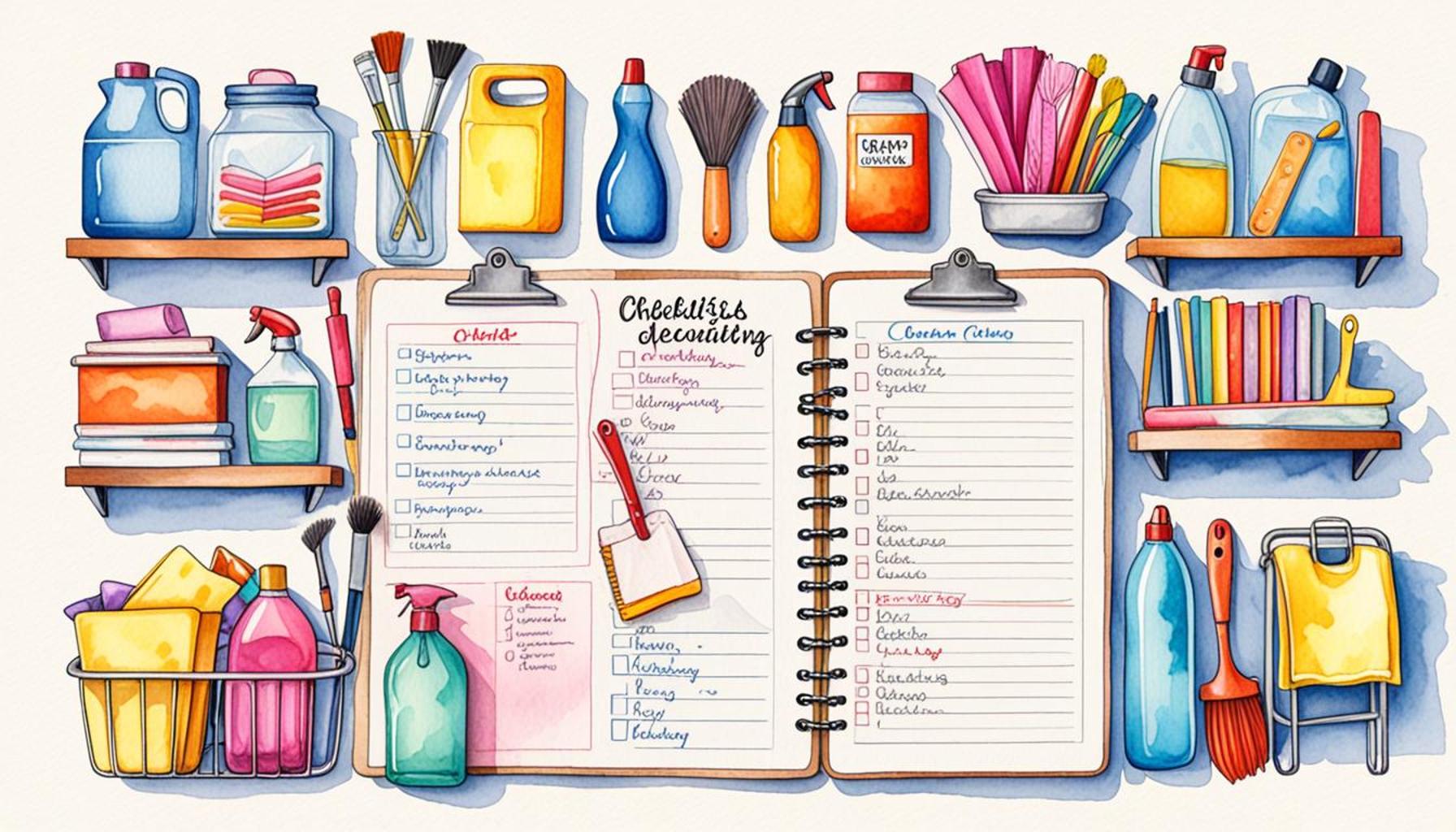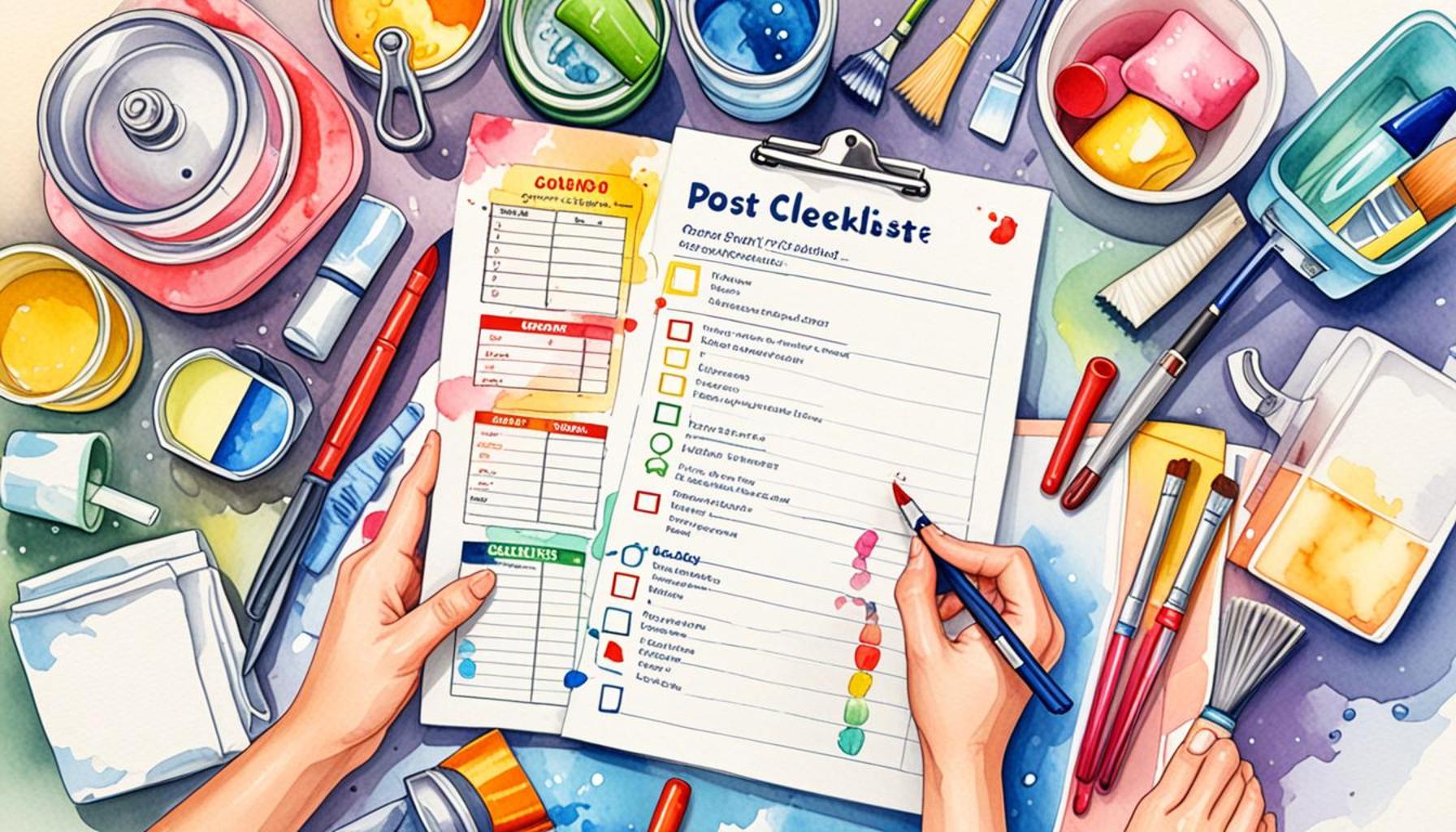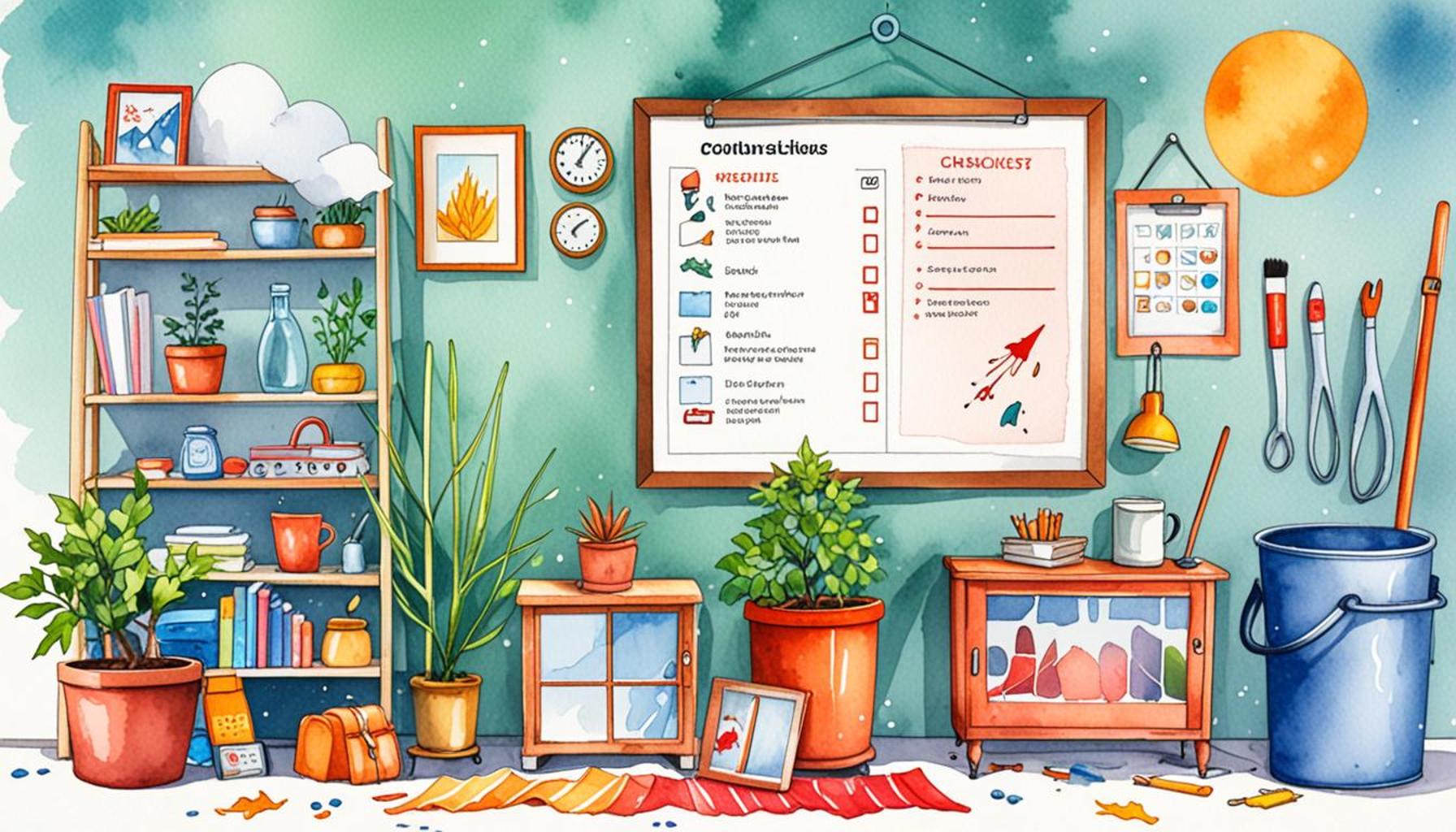Checklists for Organizing and Decluttering: Streamlining Your Cleaning Routine

Harnessing the Power of Checklists for a Cleaner Home
In the hustle of daily life, effective organization and decluttering often fall to the wayside. However, integrating a streamlined cleaning routine can usher in a refreshing change that revitalizes both your space and your mindset. A well-structured checklist serves as a powerful tool to not only simplify tasks but also to keep you motivated and focused on your goals.
Checklists can transform the way you approach cleaning by helping you:
- Stay focused on immediate cleaning goals: This prevents distractions that can often derail your cleaning efforts.
- Break down larger tasks into manageable steps: For instance, instead of “clean the entire kitchen,” you could break it down into “empty the dishwasher,” “wipe down countertops,” and “organize the pantry.”
- Track your progress and celebrate small victories: Each completed task can serve as motivation, creating a sense of achievement that propels you forward.
Effective Strategies for Implementing Checklists
Implementing checklists into your cleaning routine can be straightforward with some strategic planning. Here are a few approaches to consider:
- Daily Cleaning: Create a checklist that covers your most frequent chores, such as making your bed, doing the dishes, and vacuuming high-traffic areas. This daily maintenance prevents clutter from accumulating and makes your home feel more inviting.
- Weekly Organization: Reserve specific days for deeper cleaning and decluttering sessions. For example, you could dedicate Saturdays to focus on laundry and bathroom cleaning, while Sundays can be used for organizing your closet or sorting through mail.
- Seasonal Deep Clean: Outline intensive tasks for an annual overhaul of your living space. This might include cleaning out your garage, washing windows, or decluttering storage areas that have become catch-alls over the year.
The Transformative Impact of Checklists
As you delve deeper into the world of checklists for organizing and decluttering, you will discover their profound ability to reshape your cleaning habits. These handy guides enhance efficiency, not just in the act of cleaning but in fostering a mindset that values order and tranquility.
Moreover, the psychological benefit of checking off completed tasks cannot be overstated. It creates a satisfying sense of accomplishment that can encourage you to tackle even larger projects with enthusiasm. Consider joining online communities or forums where people share their checklist strategies and experiences. Engaging with others can provide you with fresh perspectives and new ideas that might inspire you to refine your own approaches.
Checklists can ultimately transform your home into a sanctuary of order and peace, making each corner of your space not just tidy, but also a reflection of your personal style and comfort. The journey to a more organized life begins with that first checked box—so why not start today?
DISCOVER MORE: Click here for DIY cleaning solutions
Crafting Your Personalized Cleaning Checklist
Developing a personalized checklist for organizing and decluttering can seem daunting at first, but breaking the process down into structured components can make it significantly more manageable. A great starting point is to assess the unique needs of your living environment. Each household has its own rhythm, family dynamics, and areas that demand more attention than others. By recognizing these nuances, you can create a checklist that serves your specific situation, making your cleaning routine far more effective.
Begin with a nearly blank slate—consider the primary areas in your home that require regular upkeep. Think of rooms such as the kitchen, living room, bedroom, and bathroom, each contributing to the overall functionality and comfort of your home. Once you’ve identified these spaces, it helps to break each area down into actionable tasks that can be scheduled daily, weekly, or monthly. Here’s a basic framework to inspire you:
- Kitchen:
- Wipe down kitchen counters and tables after each meal.
- Empty the sink and load the dishwasher nightly.
- Clean out the refrigerator weekly, discarding expired items.
- Organize pantry items monthly to keep everything accessible.
- Living Room:
- Dust surfaces once a week, focusing on electronics and décor.
- Vacuum or sweep floors multiple times a week, depending on foot traffic.
- Declutter by evaluating magazines, books, and decor items monthly.
- Bedroom:
- Make the bed each morning to create an inviting space.
- Sort clothes weekly: put away clean laundry and address items needing repair or donation.
- Rotate seasonal clothing bi-annually to streamline closet space.
- Bathroom:
- Wipe down surfaces after use to minimize buildup.
- Deep clean showers and toilets weekly.
- Purge expired toiletries every three months to keep supplies fresh.
By not only identifying tasks but allocating specific times for them, you create a routine that seamlessly integrates into your day. This approach provides clarity and organization, reducing the sense of overwhelm that often accompanies cleaning. Additionally, while you work toward creating these list items, it might be helpful to incorporate reminders or alarms in your smartphone to prompt you as needed, ensuring that nothing falls through the cracks.
Encouraging Experts and Resources
Utilizing resources from cleaning experts and professional organizers can offer you insights into best practices for creating these checklists. Websites such as Pinterest and home improvement blogs are treasure troves of templates and printable materials designed to simplify your cleaning process. You may even consider investing in cleaning apps that offer customizable features, tracking your progress and allowing you to adjust your checklist as necessary.
In conclusion, tailoring your cleaning checklist not only fits your lifestyle but also enhances your ability to maintain a tidy space. With these practical strategies, you can take your first steps towards a more organized home that reflects peace, productivity, and your personal aesthetic.
Discovering the Power of Checklists
When it comes to organizing and decluttering, checklists serve as powerful tools that help streamline your cleaning routine. These handy lists not only allow you to visualize your tasks but also provide a sense of accomplishment as you check each item off. By establishing a clear sequence of actions, you can break down overwhelming cleaning projects into manageable steps, leading to increased productivity.
Prioritization and Efficiency
One of the greatest advantages of using checklists for cleaning is the ability to prioritize tasks based on urgency and importance. Whether it’s tackling daily chores or seasonal deep-cleaning, a well-organized checklist helps you manage your time effectively. You will know which areas need immediate attention, allowing you to focus on high-impact cleaning first, rather than getting sidetracked.
| Category | Benefits |
|---|---|
| Time Management | Checklists allow for efficient allocation of time, helping avoid last-minute cleaning. |
| Motivation | The act of checking off tasks boosts morale and encourages continued progress. |
Creating Personalized Checklists
Personalization is key when it comes to streamlining your cleaning routine. Tailoring your checklists to fit your lifestyle and cleaning preferences can maximize their effectiveness. You might consider categorizing tasks by room or type of activity—like dusting, vacuuming, or decluttering. Additionally, adding a timeline to your checklists can help you establish a rhythm to your cleaning schedule.
Implementing these strategies opens pathways to developing a sustainable cleaning habit that not only keeps your space welcoming and tidy but enhances your overall well-being.
CHECK OUT: Click here for the latest cleaning innovations
Implementing a Decluttering Strategy
Creating a personalized cleaning checklist is a vital step in achieving a more organized home; however, it is equally important to develop an effective decluttering strategy. Decluttering involves making thoughtful decisions about what to keep, donate, or discard, ultimately contributing to a more functional living space. To facilitate this process, consider the Four-Box Method, a popular approach that simplifies decision-making by categorizing items into four boxes: keep, donate, trash, and relocate.
When implementing this strategy, start by focusing on one room or area at a time, as this decreases the chances of feeling overwhelmed. For instance, if you choose to declutter your bedroom, designate a specific timeframe—perhaps an hour on a Saturday morning. Take a deep breath and begin sorting through items. Here’s how the Four-Box Method works:
- Keep: These are items you use regularly or have significant sentimental value. Ensure that everything you keep has a designated place to promote an organized setup.
- Donate: Identify items that are in good condition but no longer serve a purpose in your home. Local charities and shelters often welcome donations, and some organizations also offer pick-up services for larger items.
- Trash: Dispose of items that are broken, unusable, or expired. Don’t hesitate to let go of things that contribute more clutter than joy.
- Relocate: This box is for items that belong in another area of the home. Ensure they are returned to their rightful place promptly to maintain organization.
Implementing the Four-Box Method not only highlights the need to declutter but also makes the process feel less daunting while keeping your checklist up to date. As you tackle each area of your home, update your cleaning checklist based on the findings—if you discover several items to donate, note that down to remind you to take these items the next time you’re out.
Utilizing Time-Saving Strategies
Streamlining your cleaning routine can also be achieved by utilizing time-saving strategies. The common “20-minute tidy” is an effective method that can be seamlessly integrated into your checklist. Set a timer for just twenty minutes and focus on decluttering or cleaning one specific area. You’ll be surprised at how much can be accomplished in such a short time. Make it a routine at the end of the day or week for sustained progress in maintaining a clean environment.
Another useful tactic is effectively incorporating cleaning zones into your checklist. Instead of attempting to clean the entire house at once, divide your home into sections and work on one zone per day. For example, dedicate Mondays to kitchen cleaning, Tuesdays for bathrooms, and so on. This method not only enhances focus but also promotes efficiency as each cleaning session remains manageable.
Additionally, consider involving all members of the household in the cleaning process. Assign tasks based on the age and capability of the individuals, transforming cleaning into a collaborative effort. By gamifying the experience, such as setting a timer for each person to see who can declutter the most in their assigned zone, you can foster responsibility while making the chore enjoyable.
As you work through these strategies, remember that the foundation of an effective cleaning routine lies in a well-crafted checklist. Your checklist evolves with your needs, reminding you to declutter and create an inviting space conducive to relaxation and productivity. By incorporating innovative methods and technologies, you pave the way for sustained organization and cleanliness in your home.
DISCOVER MORE: Click here to learn how to choose the right cleaning products
Conclusion
In the pursuit of a more organized and decluttered home, checklists serve as our invaluable allies. By adopting a structured approach to cleaning and decluttering, such as those presented in the Four-Box Method, we can transform overwhelming tasks into manageable segments that fit comfortably within our schedules. Each item marked off your checklist not only signifies a task completed but also a step toward a more serene living space.
Moreover, utilizing time-saving strategies, such as the 20-minute tidy and defining cleaning zones, can further simplify your routine, ensuring you maintain a clean home without it feeling like a chore. By designating specific areas for decluttering and involving all household members, the cleaning process can become a collaborative effort that not only lightens the workload but also fosters a sense of community and responsibility.
Overall, the key to effective organization lies in the continuous adaptation of your checklist. As your needs evolve, so too should your strategies, allowing you to not only maintain an orderly home but also create an inviting environment for relaxation and productivity. Embrace these innovative techniques and witness the transformation of your cleaning routine into a simpler, more enjoyable experience. Now is the time to streamline your cleaning efforts—empower yourself with the tools and strategies discussed, and take the first step towards reclaiming your space!


